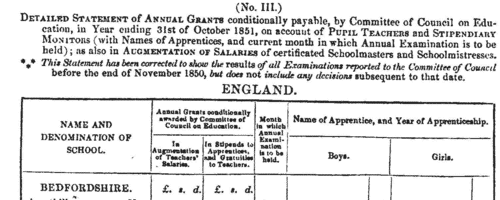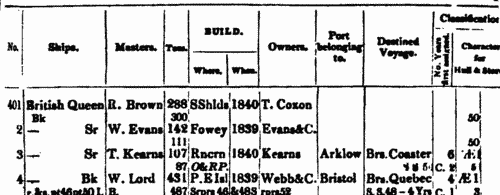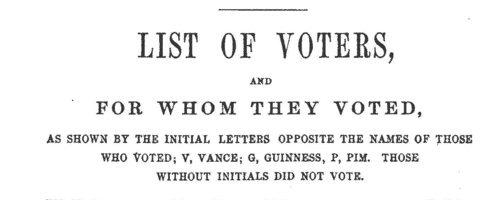Mullany Surname Ancestry ResultsOur indexes 1845-1865 include entries for the spelling 'mullany'. In the period you have requested, we have the following 7 records (displaying 1 to 7): Buy all | | | Get all 7 records to view, to save and print for £42.00 |
These sample scans are from the original record. You will get scans of the full pages or articles where the surname you searched for has been found. Your web browser may prevent the sample windows from opening; in this case please change your browser settings to allow pop-up windows from this site. Inhabitants of Derbyshire
(1846)
Samuel Bagshaw's Derbyshire directory lists traders, farmers and private residents in the county by town, parish and/or township.MULLANY. Cost: £6.00.  | Sample scan, click to enlarge

|  Inhabitants of Newington in Surrey
(1851) Inhabitants of Newington in Surrey
(1851)
The 1851 census return for St Mary Newington, Surrey, registration district: St Peter Walworth sub-district: enumeration district 9: described as: "All that Part of the Parish of St. Mary Newington, which Comprises The East side of Providence St., South side of Walworth Common to Wellington Place. Including Johns Place (both sides), Upton Place, St. Pauls Place, Villa St. both sides to Parish boundary, Walworth Villa, and Lebanon Place". This area lay in the ecclesiastical district of St Peter Walworth, and in the borough of Lambeth. HO 107/1567. The addresses listed in the actual returns are 2 to 8 and 18 to 20 Providence Street; 1 to 5 Providence Place; 7 to 11 Portland Terrace; 1 to 10 John Place; 1 to 3 Upton Place; 2 to 4 Upton Cottages; 1 to 5 St Pauls Cottages, 1 to 12 St Pauls Place; 1 to 9 Villa Place; 1 to 3 Villa Street; 1 to 10 and 18 Villa Row; Villa House; Hour Glass public house; 1 to 6 Trafalgar Row; 1 to 7 Villa (including Infant School for the Pauper Children); 1 to 5 Lebanon Place; various numbers Westmoreland Place; and Wellington Cottage.MULLANY. Cost: £4.00.  | Sample scan, click to enlarge

| Pupil Teachers in Middlesex: Boys
(1851)
The Committee of Council on Education awarded annual grants for the training and support of pupil teachers and stipendiary monitors in schools in England, Wales, Scotland, the Isle of Man and the Channel Islands. Pupil teachers started training between the ages of 13 and 15, and 'must not be subject to any bodily infirmity likely to impair their usefulness as Pupil Teachers, such as scrofula, fits, asthma, deafness, great imperfections in the sight or voice, the loss of an eye from constitutional disease, or the loss of an arm or leg, or the permanent disability of either arm or leg, curvature of the spine, or a hereditary tendency to insanity'.
They also had to obtain certificates from the managers of the school (and their clergyman, in the case of Church of England schools) as to their moral character and that of their family; good conduct; punctuality, diligence, obedience, and attention to duty; and attentiveness to their religious duties.
This detailed statement in the annual report of the committee for the year ending 31 October 1851 lists schools by county, giving:
1. Name and Denomination of School, with these abbreviations - B, British and Foreign School Society; F. C., Free Church of Scotland; H. C., Home and Colonial School Society; N., National Society, or connected with the Church of England; R. C., Roman Catholic Poor-School Committee; Wesn., Wesleyan Methodist.
2. Annual grants conditionally awarded by the committee in augmentation of teachers' salaries, and in stipends to apprentices, and gratuities to teachers.
3. Month in which annual examination was to be held.
4. Names of apprentices, giving surname and initials, and year of apprenticeship. Stipendiary monitors are indicated by (S. M.).MULLANY. Cost: £6.00.  | Sample scan, click to enlarge

| Owners of Merchantmen
(1852-1853)
Lloyd's Register of British and Foreign Shipping was issued annually, listing ships that had been surveyed preparatory to being insured. This is the register issued 1 July 1852 and then annotated as ships were re-surveyed through to 30 June 1853. The ships were numbered by the first letter of their name, and then by number alphabetically through the ships' names and within ships of the same name alphabetically by surname of the master. After the name of the ship there is the type of vessel (Bk, barque; Bg, brig; Bn, brigantine; Cr, cutter; Dr, dogger; G, galliott; H, hoy; K, ketch; Lr, lugger; Pol, polacre; S, ship; Sk, smack; Sp, sloop; Sr, schooner; St, schoot; Stm, steamer; Sw, snow; Yt, yacht), master's name (as at the time of the last survey); tonnage; place and year of build; owners; port belonging to; destined voyage; number of years first assigned; and character for hull and stores (e. g., A 1), with the year or month (e. g., 50 for 1850, or 2 for February 1852) of inspection. Underneath some entries details were given of construction and repair, with year - s., sheathed; d., doubled; C., coppered; I. B., iron bolts; c. f., copper fastened; M., sheathed with marine metal; Y. M., sheathed with yellow metal; G., sheathed with galvanised iron; Z., sheathed with zinc; F., felt; C. lm., coppered to light water or ballast mark; C. T., copper bolts substituted for treenails; Cl., clincher; len., lengthened; lrp., large repairs; trp., thorough repairs; Drp., damage repaired; ND., new deck; N TSds., new top-sides; W. C., wales cased; NW., new wales; NB., new bottom; NK., new keel; plk, Plank; N Klsn, new kelson; alm. rb., almost rebuilt; pt O. M., part old materials (timbers or plank); Srprs, some repairs - and, in italics, the timber of the ship is described - A, ash; B B, black birch; Bh, beech; C, cedar; E, elm; F, fir; G, gum; Ght, greenheart; Hk, hackmatack; Hm, hemlock; L, locust; Lh, larch; L O, live oak; M, mahogany; P, pine; P P, pitch pine; R P, red pine; Y P, yellow pine; S, spruce; T, teak; Tam, tamarac; W H, witch hazel; W O, white oak. The sample scan is from the main list. The third column, reserved for masters' names, is not particularly wide; with short surnames, an initial will be given; but longer surnames omit the initials, and even longer surnames are abbreviated. This is the index to owners in the main list. Often a ship would have changed hands by the time of re-survey, and the new owners' names are added in slightly smaller type under the original owners in the seventh column. These new owners are also included in this index. It should be borne in mind that the owners in the main list are those at the time of the respective previous survey for each ship, not necessarily as of 1 July 1852.MULLANY. Cost: £6.00.  | Sample scan, click to enlarge

|  Persons of standing recommending London police recruits
(1843-1857) Persons of standing recommending London police recruits
(1843-1857)
The Metropolitan Police Register of Joiners (MEPO 4/334) lists policemen joining the force 1 January 1843 to 1 April 1857 (warrant numbers 19893 to 35804). The register is alphabetical, in so far as the recruits are listed chronologically grouped under first letter of surname. It gives Date of Appointment, Name, Number of Warrant, Cause of Removal from Force (resigned, dismissed, promoted or died), and Date of Removal. Although the register was closed for new entrants at the end of 1842, the details of removals were always recorded, some being twenty or more years later. Those recruits not formerly in the police, the army, or some government department, were required to provide (normally) at least two letters of recommendation from persons of standing, and details of these are entered on the facing pages. Where a recruit was only recently arrived in the metropolis, the names and addresses of the recommenders can be invaluable for tracing where he came from. Those recruits not formerly in the police, the army, or some government department, were required to provide (normally) at least two letters of recommendation from persons of standing, and details of these are entered on the facing pages: the names in these are indexed here (the police recruits are indexed separately and not included here). Recruits transferred from other forces or rejoining the force did not normally need recommendations - in the latter case, former warrant numbers are given - but some recommendations are from police inspectors, even other constables. Recruits coming from the army sometimes have general military certificates of good conduct, but most often have a letter from their former commanding officer; recruits recommended by government departments (most often the Home Office) similarly have letters from the head of department. But the great majority of the names and addresses in these pages are of respectable citizens having some sort of personal acquaintance with the recruit. Where more than two recommendations were provided, the clerk would only record one or two, with the words 'and others'. Tradesmen are sometimes identified as such by their occupations; there are some gentry. Although the bulk of these names are from London and the home counties, a scattering are from further afield throughout Britain and Ireland. MULLANY. Cost: £8.00.  | Sample scan, click to enlarge

|  British infantry fighting in China
(1860) British infantry fighting in China
(1860)
The China Medal was awarded to soldiers and sailors who took part in the prosecution of the war against the Chinese from 1856 to 1860. Separate clasps were awarded for men who had been in receipt of the China Medal of 1842; for being actually present at Canton on 28 and 29 December 1857, when that city was bombarded and finally captured; for being actually engaged in the operations which ceased with the first capture of the Taku Forts, 20 May 1858, and led to the Treaty of Tientsin; for being actually present at the capture of the Taku Forts 21 August 1860; and for being actually present before Pekin the day the gate of that city was given up to the allied (British and French) army, viz. on 13 October 1860. The 99th (Lanarkshire) Regiment of Foot, based at Cork, embarked for India in September 1858, and was transferred to China in 1860; moved to South Africa in 1865, and returned to England in 1869. The regiment took part in the capture of Pekin.MULLANY. Cost: £8.00.  | Sample scan, click to enlarge

| Dublin Electors
(1865)
This alphabetical list of electors for the City of Dublin for 1865 is annotated with details of the votes cast in the election of 15 July 1865 for a member of Parliament. The candidates were John Vance, Esq., D. L. (V), Benjamin Lee Guinness, Esq., D. L., LL. D. (G), and Jonathan Pim, Esq. (P). The first column gives, in bold, the initial of the ward in which lay the property that was the elector's qualification. The second column gives the elector's sequential number (alphabetically) within that ward. Then the elector's full name is given, surname first, and address, usually including house number. The votes cast are shown on the right: where these columns are blank, the elector did not vote. The key to the ward names is: A, South Dock; B, Donnybrook; C, Rathdown; D, Trinity; E, South City; F, Royal Exchange; G, Mansion House; H, Fitzwilliam; I, Wood Quay; K, Merchants' Quay; L, Usher's Quay; M, Arran Quay; N, Inns' Quay; O, North City; P, Rotundo; Q, Mountjoy; R; North Dock. S indicates the register of freemen.MULLANY. Cost: £4.00.  | Sample scan, click to enlarge

|
Research your ancestry, family history, genealogy and one-name study by direct access to original records and archives indexed by surname.
|










